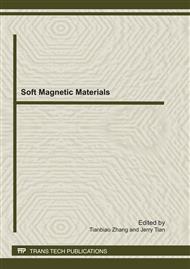[1]
J. Wang, Survey and Summary from DNA Biosensors to Gene Chips, Nucl. Acids. Res., vol. 28, Aug. 2000, pp.3011-3016, doi: 10. 1093/nar/28. 16. 3011.
DOI: 10.1093/nar/28.16.3011
Google Scholar
[2]
J. J. Gooding, Electrochemical DNA Hybridization Biosensors, Electroanalysis, vol. 14, Sep. 2002, pp.1149-1156, doi: 10. 1002/1521-4109(200209)14: 17<1149: AID-ELAN1149>3. 0. CO; 2-8.
DOI: 10.1002/1521-4109(200209)14:17<1149::aid-elan1149>3.0.co;2-8
Google Scholar
[3]
J. H. Cha, J. I. Han, Y. Choi, D. S. Yoon, K. W. Oh, and G. Lim, DNA Hybridization Electrochemical Sensor Using Conducting Polymer, Biosens. Bioelectron., vol. 18, Sep. 2003, pp.1241-1247, doi: 10. 1016/S0956-5663(03)00088-5.
DOI: 10.1016/s0956-5663(03)00088-5
Google Scholar
[4]
S. Rauf, J. J. Gooding, K. Akhtar, M. A. Ghauria, M. Rahmana, M. A. Anwara, and A. M. Khalida, Electrochemical Approach of Anticancer Drugs-DNA Interaction, J. Pharm. Biomed. Anal., vol. 37, Feb. 2005, p.205.
Google Scholar
[5]
S. C. Garrett, L. Hodgson, A. Rybin, A. Toutchkine, K. M. Hahn, D. S. Lawrence, and A. R. Bresnick, A Biosensor of S100A4 Metastasis Factor Activation: Inhibitor Screening and Cellular Activation Dynamics, Biochemistry, vol. 47, Jan. 2008, pp.986-996.
DOI: 10.1021/bi7021624
Google Scholar
[6]
D. Ozkan, A. Erdem, P. Kara, K. Kerman, B. Meric, J. Hassmann, and M. Ozsoz, Allele-Specific Genotype Detection of Factor V Leiden Mutation from Polymerase Chain Reaction Amplicons Based on Label-Free Electrochemical Genosensor, Anal. Chem., vol. 74, Dec. 2002, p.5931.
DOI: 10.1021/ac0257905
Google Scholar
[7]
E. Palecek, S. Billova, L. Havran, R. Kizek, A. Miculkova, and F. Jelen, DNA Hybridization at Microbeads with Cathodic Stripping Voltammetric Detection, Talanta, vol. 56, Apr. 2002, p.919–930, doi: 10. 1016/S0039-9140(01)00666-X.
DOI: 10.1016/s0039-9140(01)00666-x
Google Scholar
[8]
Q. X. Wang, X. L. Yuan, K. Jiao, J. K. Xie, and B. Zhong, The Non-Labeling Electrochemical Active Deoxyribonucleic Acid . Hybridization Indicators, Prog. Chem., vol. 19, Jun. 2007, pp.1007-1015, doi: CNKI: ISSN: 1005-281X. 0. 2007-06-015.
Google Scholar
[9]
J. Wang, G. Rivas, J. R. Fernandes, J. L. L. Paz, M. Jiang, and R. Waymire, Indicator-Free Electrochemical DNA Hybridization Biosensor, Anal. Chim. Acta, vol. 375, Nov. 1998, p.197–203, doi: 10. 1016/S0003-2670(98)00503-0.
DOI: 10.1016/s0003-2670(98)00503-0
Google Scholar
[10]
C. N. Campbell, D. Gal, N. Cristler, C. Banditrat, and A. Heller, Enzyme-Amplified Amperometric Sandwich Test for RNA and DNA, Anal. Chem., vol. 74, Jan. 2002, p.158–162, doi: 10. 1021/ac015602v.
DOI: 10.1021/ac015602v
Google Scholar
[11]
S. O. Kelley, E. M. Boon, J. K. Barton, N. M. Jackson, and M. G. Hill, Single-Base Mismatch Detection Based on Charge Transduction through DNA, Nucleic Acids Res., vol. 27, Dec. 1999, p.4830–4837, doi: 10. 1093/nar/27. 24. 4830.
DOI: 10.1093/nar/27.24.4830
Google Scholar
[12]
D. H. Johnston, K. C. Glasgow, and H. H. Thorp, Electrochemical Measurement of the Solvent Accessibility of Nucleobases Using Eletrntransfer between DNA and Metal-Complexes, J. Am. Chem. Soc., vol. 117, Sep. 1995, p.8933.
DOI: 10.1021/ja00140a006
Google Scholar
[13]
S. Takenaka, K. Yamashita, M. Takagi, Y. Uto, and H. Kondo, DNA Sensing on a DNA Probe-Modified Electrode Using Ferrocenylnaphthaene Diimide as the Electrochemically Active Ligand, Anal. Chem., vol. 72, Mar. 2000, p.1334.
DOI: 10.1021/ac991031j
Google Scholar
[14]
L. S. Elicia, P. Erohkin, and J. J Gooding, A Comparison of Cationic and Anionic Intercalators for the Electrochemical Transduction of DNA Hybridization via Long Range Electron Transfer, Electrochem Com., vol. 6, Jul. 2004, pp.648-654.
DOI: 10.1016/j.elecom.2004.05.002
Google Scholar
[15]
L. S. Elicia, Wong, J. F. Mearms, and J. J. Gooding, Further Development of an Electrochemical DNA Hybridization Biosensor Based on Long-range Electron Transfer, Sens. Actuators, B, vol. 111-112, Nov. 2005, pp.515-521.
DOI: 10.1016/j.snb.2005.03.072
Google Scholar
[16]
Z. F. Liu, Z. Y. Shen, T. Zhu, S. F. Hou, and L. Z. Ying, Organizing Single-Walled Carbon Nanotubes on Gold Using a Wet Chemical Self-Assembling Technique, Langmuir, vol. 16, Apr. 2000, pp.3569-3573, doi: 10. 1021/la9914110.
DOI: 10.1021/la9914110
Google Scholar


